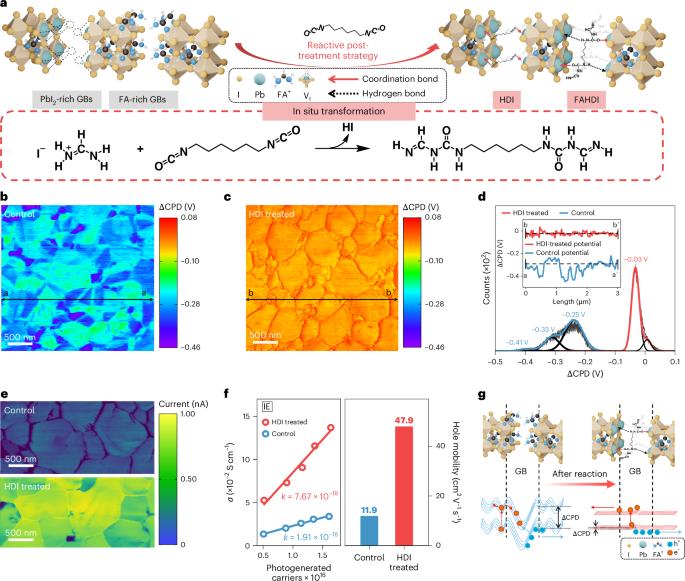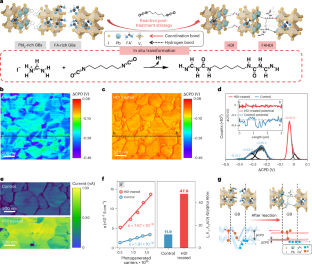通过亲电反应制备后处理增强无空穴导体、可印刷介观钙钛矿太阳能电池
IF 60.1
1区 材料科学
Q1 ENERGY & FUELS
引用次数: 0
摘要
通过将钙钛矿渗透到预印多孔TiO2/ZrO2/碳三层支架中制备无孔导体可印刷介观钙钛矿太阳能电池,为光伏板的工业化生产提供了一种方法。在这里,我们介绍了一种使用六亚甲基二异氰酸酯的反应后处理策略,以实现从钙钛矿到碳电极的空穴的有效收集和运输。六亚甲基二异氰酸酯通过亲电反应与钙钛矿晶体末端多余的有机阳离子发生反应,重建晶界和后界面。该处理钝化了缺陷,促进了钙钛矿中的空穴传输,并增强了从钙钛矿到碳电极的空穴转移。孔径面积为0.1 cm2的实验室尺寸器件的效率为23.2%,孔径面积为57.3 cm2的微型模块的效率为19.4%。在55±5℃的高温下,在最大功率点连续工作900小时后,器件保持95%的初始效率。本文章由计算机程序翻译,如有差异,请以英文原文为准。


Enhancing hole-conductor-free, printable mesoscopic perovskite solar cells through post-fabrication treatment via electrophilic reaction
Hole-conductor-free printable mesoscopic perovskite solar cells, fabricated by infiltrating perovskite into the preprinted porous TiO2/ZrO2/carbon triple-layer scaffold, offer an approach for the industrial production of photovoltaic panels. Here we introduce a reactive post-processing strategy using hexamethylene diisocyanate to enable efficient collection and transport of holes from the perovskite to the carbon electrode. Hexamethylene diisocyanate reacts with excess organic cations at the perovskite crystal terminations through an electrophilic reaction and reconstructs the grain boundaries and the back interface. The treatment passivates defects, facilitates hole transport in perovskite and enhances hole transfer from the perovskite to the carbon electrode. We achieve an efficiency of 23.2% for the laboratory-size device with an aperture area of 0.1 cm2 and 19.4% for the minimodule with an aperture area of 57.3 cm2. The devices retain 95% of their initial efficiency after 900 h of continuous operation at the maximum power point under elevated temperatures of 55 ± 5 °C. Printable mesoscopic perovskite solar cells are a promising device design, yet their efficiency is limited by charge collection. Ma et al. use hexamethylene diisocyanate to eliminate unreacted organic cations at grain boundaries, enhancing hole collection.
求助全文
通过发布文献求助,成功后即可免费获取论文全文。
去求助
来源期刊

Nature Energy
Energy-Energy Engineering and Power Technology
CiteScore
75.10
自引率
1.10%
发文量
193
期刊介绍:
Nature Energy is a monthly, online-only journal committed to showcasing the most impactful research on energy, covering everything from its generation and distribution to the societal implications of energy technologies and policies.
With a focus on exploring all facets of the ongoing energy discourse, Nature Energy delves into topics such as energy generation, storage, distribution, management, and the societal impacts of energy technologies and policies. Emphasizing studies that push the boundaries of knowledge and contribute to the development of next-generation solutions, the journal serves as a platform for the exchange of ideas among stakeholders at the forefront of the energy sector.
Maintaining the hallmark standards of the Nature brand, Nature Energy boasts a dedicated team of professional editors, a rigorous peer-review process, meticulous copy-editing and production, rapid publication times, and editorial independence.
In addition to original research articles, Nature Energy also publishes a range of content types, including Comments, Perspectives, Reviews, News & Views, Features, and Correspondence, covering a diverse array of disciplines relevant to the field of energy.
 求助内容:
求助内容: 应助结果提醒方式:
应助结果提醒方式:


